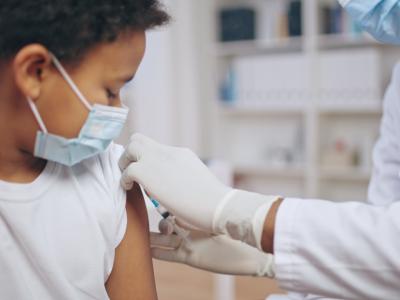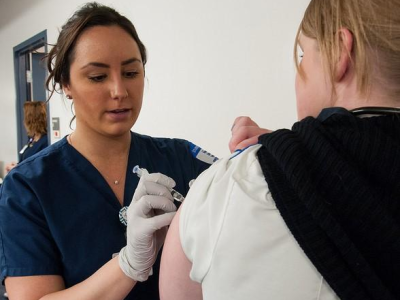Study: Fatal cases of Ebola after complete recovery rare
Late death from Ebola disease in survivors of earlier episodes is very rare, occurring in less than 1% of patients in a cohort study of Sierra Leone survivors published yesterday in BMJ. The study additionally found that the infecting dose of Ebola as measured by exposure level does not affect the severity of disease.
The authors, from England and Sierra Leone, several of whom served on response teams in the latter country, followed 151 Ebola survivors discharged from a Sierra Leone treatment center from November 2014 to March 2015 for up to 13 months. Four patients (0.7%) died during a mean follow-up period of 10 months, only one of them after apparent full recovery (late complications or tuberculosis were the likely causes of death in the others).
The households of the 151 survivors comprised 395 people in whom Ebola developed and an additional 53 who had probable Ebola; 227 of the former plus 11 of the latter died of their disease, for case-fatality rates of 57.5% (227/395) and 53.1% (238/448), respectively.
Exposure levels were ascertained by questioning the survivors about symptoms and about who had taken care of them and shared other activities. Household members were also interviewed about their level of contact with the patient and with his or her body fluids. Increasing exposure correlated with increased risk of disease, although no consistent trend was apparent between case-fatality rate and level of exposure.
The authors say their findings of the rarity of recurrent Ebola resulting in death "should be reassuring for Ebola survivors and their contacts, but does not remove the need for continued monitoring of survivors' health."
May 17 BMJ study
CDC reports 133 cases of Salmonella in 26 states tied to small turtles
From Jan 16, 2015, through Apr 8 of this year a total of 133 people from 26 states have become infected with Salmonella linked to contact with small turtles, the Centers for Disease Control and Prevention (CDC) said today. The cases occurred during four outbreaks traced to the Sandiego, Poona, and IIIb 61:i:z53 strains of Salmonella.
The numbers are up from 51 cases in 16 cases involving the Sandiego and Poona outbreaks in the CDC's initial statement on the outbreak, on Oct 9, 2015.
Of the 133 people infected, 38 were hospitalized, but no deaths have occurred, the CDC said. Children 5 years of age or younger account for 41% of the cases.
Of 110 case-patients interviewed, 55 (50%) reported contact with small turtles or their environment (eg, water from their habitat) within the week before their illness developed.
The sale and distribution of turtles with shell length less than 4 inches was banned in the United States by the Food and Drug Administration in 1975. In the current study, 25 (45%) of the 55 case-patients with a known history of contact with small turtles bought them from street vendors.
Turtles carrying Salmonella can appear to be healthy and clean, stresses the CDC, but they can shed the bacteria in their feces, contaminating their bodies and their environment. The agency added that the outbreak is expected to continue at a low level for several months because many people remain unaware of the risk of Salmonella from small turtles and their environment.
May 18 CDC report
CDC advice to pet owners
Oct 12, 2015, CIDRAP News story on outbreak
CDC upgrades pathogen-identifying tool MicrobeNet
The CDC today announced that it has upgraded its MicrobeNet online tool to help labs in hospitals and health departments across the country to identify faster rare pathogens like Elizabethkingia, which has caused recent illnesses in Wisconsin, Michigan, and Illinois.
Since 2013 MicrobeNet has helped lab workers and physicians identify pathogens via DNA sequencing or biochemical testing, the CDC said in a news release. The tool provides access to the CDC's virtual microbe library of more than 2,400 rare and emerging infectious bacteria and fungi at no cost.
Now however, the CDC has partnered with Bruker Corp., of Billerica, Mass., to add a new module to help identify bacteria and fungi faster—in just a few hours. Using Bruker's MALDI Biotyper systems, users will now be able to identify pathogens based on their protein signatures as well as the previous two methods. The new MicrobeNet module will be immediately available to professionals using the Bruker system in labs nationwide, the CDC said.
In addition to being faster, use of the MALDI module in MicrobeNet offers substantial cost savings for clinical and public health laboratories because they no longer will need to develop their own pathogen libraries, the CDC said. The labs will also be assured that their information has been confirmed by CDC experts. In addition, for many bacteria, MicrobeNet provides information about antibiotic resistance.
The CDC's John R. McQuiston, PhD, MicrobeNet team lead, said, "This system helps public health labs and hospitals quickly identify some of the most difficult pathogens to grow and detect. In turn, MicrobeNet will help treat patients faster and allow health departments to respond to public health emergencies more effectively."
May 18 CDC news release
MicrobeNet home page










